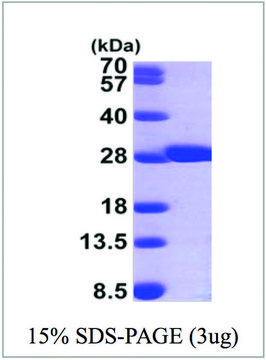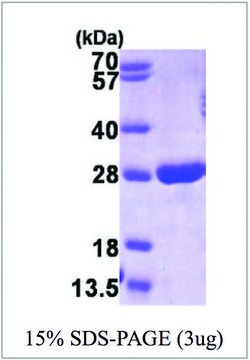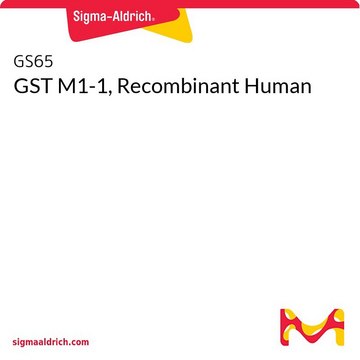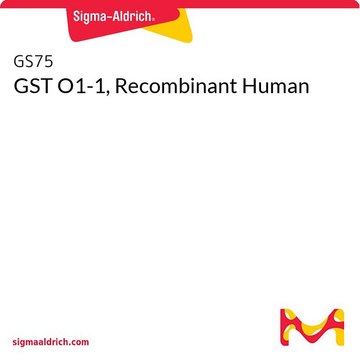GS90
GST T1-1, Recombinant Human
Synonym(s):
glutathione S-transferase theta 1
Sign Into View Organizational & Contract Pricing
All Photos(1)
About This Item
UNSPSC Code:
12352200
NACRES:
NA.26
Recommended Products
biological source
human
Quality Level
recombinant
expressed in E. coli
Assay
95% (SDS-PAGE)
form
frozen liquid
specific activity
8.8 units/mg protein
mol wt
25 kDa
concentration
1.95 mg/mL
storage temp.
−70°C
Gene Information
human ... GSTT1(2952)
General description
Glutathione S-transferase theta 1 (GSTT1) and GSTT2/GSTT2B share 55% amino acid sequence identity and may play a role in human carcinogenesis. The GSTT1 gene is haplotype-specific and is absent from 38% of the population. Alternative splicing of this gene results in multiple transcript variants.GSTT1 is an enzyme that in humans is encoded by the GSTT1 gene. The GSTT1 gene contains five exons and four introns and spans 8092bp on genomic DNA. It is mapped to human chromosome 22q11.23. This gene codes for a 240 amino acids, which is mainly expressed in human liver. Based on their biochemical, immunologic, and structural properties, cytosolic and membrane-bound forms of glutathione S-transferase are encoded by two distinct supergene families. At present, eight distinct classes of the soluble cytoplasmic mammalian glutathione S-transferases have been identified: α, κ, μ, ω, π, σ, θ and ζ.
as assayed by the spectrophotometric determination of NADPH oxidation coupled to the glutathione peroxidase activity of GST T1-1 on cumene hydroperoxide (1.5 mM) in the presence of reduced glutathione (1 mM) in 100 mM NaPO4 (pH 7.0) at room temperature.
Biochem/physiol Actions
Glutathione S-transferase theta 1 (GSTT1) is an enzyme that in humans is encoded by the GSTT1 gene. Glutathione S-transferases (GSTs) are a family of enzymes that play an important role in detoxification by catalyzing the conjugation of many hydrophobic and electrophilic compounds with reduced glutathione. Mutation in the gene might lead to the development of lung, head and neck cancer. The GSTs are thought to function in xenobiotic metabolism and play a role in susceptibility to cancer, and other diseases.
Storage and Stability
The enzyme should be used by the end-user customer within 1 year of receipt.
Storage Class Code
10 - Combustible liquids
WGK
WGK 1
Flash Point(F)
Not applicable
Flash Point(C)
Not applicable
Regulatory Information
常规特殊物品
Choose from one of the most recent versions:
Certificates of Analysis (COA)
Lot/Batch Number
Don't see the Right Version?
If you require a particular version, you can look up a specific certificate by the Lot or Batch number.
Already Own This Product?
Find documentation for the products that you have recently purchased in the Document Library.
Ender Coskunpinar et al.
Asian Pacific journal of cancer prevention : APJCP, 15(5), 2319-2321 (2014-04-11)
Our aim was to determine GSTT1 expression levels in left colon tumors and paired normal tissue in order to identify specific alterations in GSTT1 mRNA levels. Alterations in GSTT1 expression in twenty-four left- sided colon tumors and paired cancer free
Bacterial glutathione S-transferases: what are they good for?
Vuilleumier, S, et al.
Journal of Bacteriology, 179, 1431-1431 (1997)
GSTT1 null genotype contributes to lung cancer risk in asian populations: a meta-analysis of 23 studies
Yang, X, et al.
PLoS ONE, 8 (2013)
Glutathione and glutathione-dependent enzymes represent a co-ordinately regulated defence against oxidative stress
Hayes, J. D, et al.
Free Radical Research, 31, 273-300 (1999)
Dan Wang et al.
Molecular biology reports, 41(11), 7423-7430 (2014-08-05)
Conflicting results in previous case-control studies on the association between Glutathione S-transferase T1 (GSTT1) gene polymorphism and Parkinson's disease (PD) risk have been reported, so we conducted this meta-analysis. We searched and extracted data from 3 Chinese and 3 English
Our team of scientists has experience in all areas of research including Life Science, Material Science, Chemical Synthesis, Chromatography, Analytical and many others.
Contact Technical Service





![[1,1′-Bis(diphenylphosphino)ferrocene]dichloropalladium(II)](/deepweb/assets/sigmaaldrich/product/structures/130/734/8846aa26-1858-458a-998d-8c306c13bf0f/640/8846aa26-1858-458a-998d-8c306c13bf0f.png)


